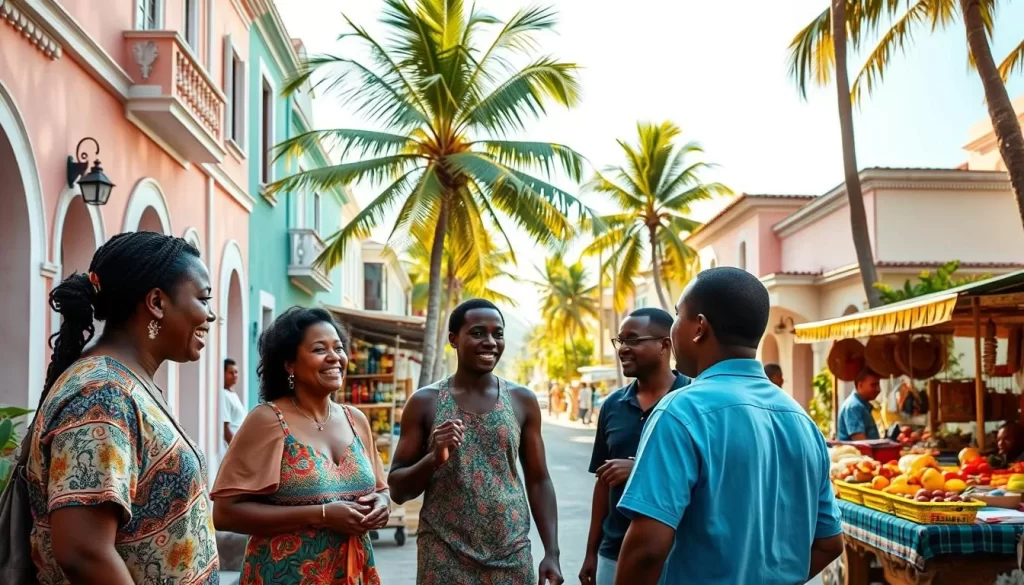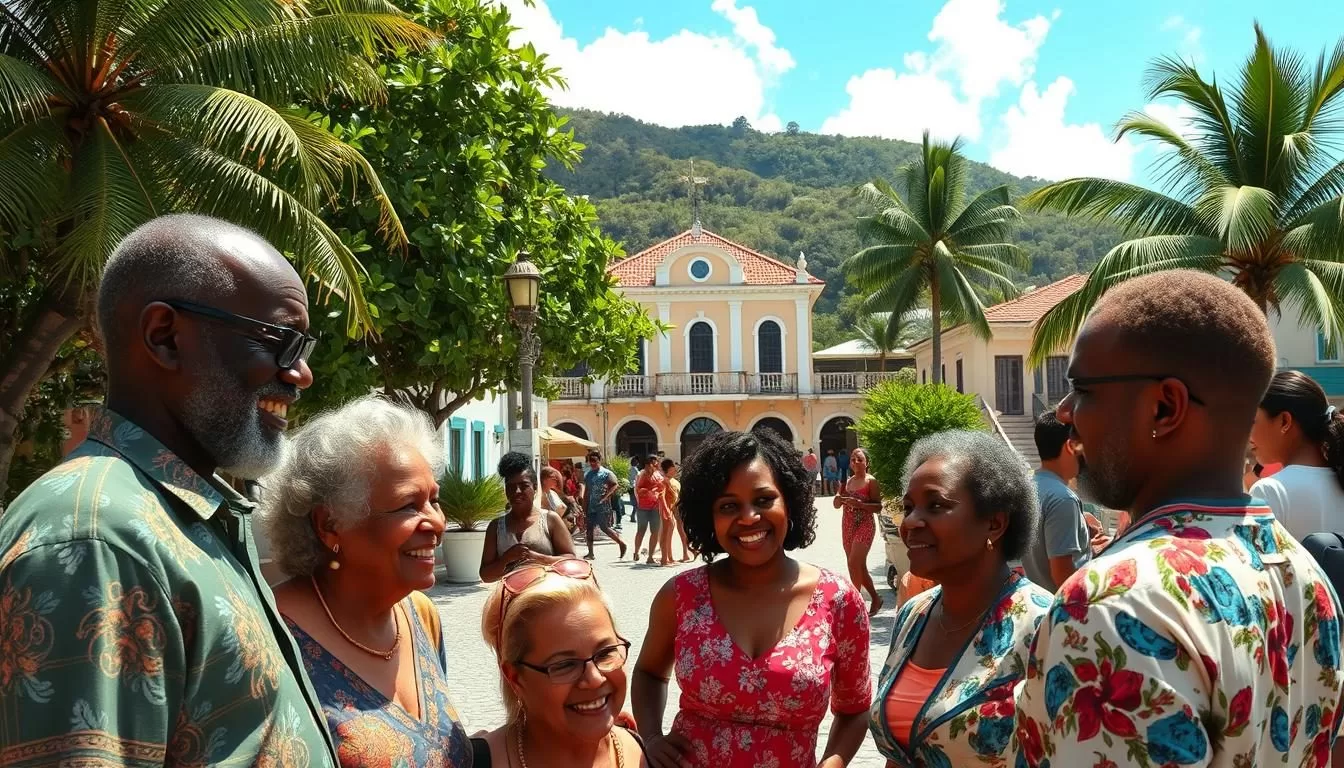✓ Accommodations✓ Flights✓ Rental Cars✓ Tours & Activities
The U.S. Virgin Islands boast a rich linguistic heritage that reflects their unique history. English serves as the official language, a legacy of the territory’s transfer from Danish rule in 1917. This shift marked a turning point in the islands’ cultural and administrative identity.
While English dominates daily communication, the islands’ multilingual past still resonates. Danish, once the administrative language, left a lasting imprint. Additionally, Creole dialects and Spanish contribute to the vibrant cultural mosaic of the Virgin Islands.
As a territory of the United States, the U.S. Virgin Islands have adopted language policies that support English while honoring their diverse roots. This blend of influences offers a fascinating glimpse into the islands’ cultural identity.
Overview of Language History in the U.S. Virgin Islands
European powers left a lasting mark on the islands’ linguistic identity. Over centuries, colonial influences shaped how people communicated. This rich history reveals a fascinating blend of cultures and language spoken practices.
Impact of Colonial Influences
Danish rule played a significant role in the islands’ government and administration. While Danish was used officially, it was never widely spoken by the local population. This created a unique dynamic where the language spoken in daily life differed from formal settings.
Immigrant communities also contributed to the linguistic landscape. Spanish, French, and Creole dialects added layers of diversity. These influences highlight the islands’ multicultural origin.
Transition from Danish to American Rule
In 1917, the states virgin islands became part of the united states virgin territory. This marked a pivotal shift in language policy. English became the dominant language in official matters, reflecting the new governance structure.
The transition was smooth, as English had already gained popularity. Today, it remains the primary language spoken, while other dialects continue to enrich the cultural fabric.
| Colonial Period | Primary Language | Impact |
|---|---|---|
| Danish Rule | Danish (official) | Limited use in daily life |
| American Rule | English | Dominance in governance and communication |
Diverse Official Languages and Dialects
Language in this territory is a blend of history and identity. English stands as the primary mode of communication, reflecting its role as the official language. This dominance is rooted in the region’s transition to American governance, which solidified its use in education, media, and daily life.

However, the linguistic landscape is far from monolithic. Virgin Islands Creole, an English-based dialect, plays a significant role in informal settings. This creole is enriched by African and Caribbean influences, making it a unique marker of local identity.
English and Its Dominance
English’s prominence is evident in all aspects of life. From government proceedings to classroom instruction, it serves as the unifying language. This widespread use ensures accessibility for visitors and residents alike.
Local Variations: Virgin Islands Creole
Virgin Islands Creole adds depth to the region’s linguistic identity. On St. Croix, it’s known as Crucian, while St. Thomas and St. John have their own subtle variations. These dialects reflect the islands’ distinct cultural histories.
Historical migration from across the Caribbean has further enriched this linguistic tapestry. Each wave of settlers brought new words and expressions, creating a dynamic and evolving language landscape. Today, these dialects serve as a bridge between the past and the present, connecting communities across the islands.
U.S. Virgin Islands: Official and widely spoken languages
Exploring the languages here reveals a rich tapestry of cultural connections. While English dominates as the official language, other tongues like Spanish and French add depth to the linguistic landscape. These languages thrive in informal settings, reflecting the region’s diverse heritage.

The Role of Spanish and French
Spanish has become a significant part of daily life, especially due to migration from nearby regions like Puerto Rico and the Dominican Republic. It’s common to hear Spanish in markets, festivals, and casual conversations. Similarly, French and its creole variants contribute to the cultural mosaic, particularly in communities with Caribbean roots.
These languages aren’t just spoken; they’re woven into the fabric of local traditions. From music to cuisine, Spanish and French influences are evident, showcasing the islands’ multicultural identity.
Other Languages and Historical Linguistic Layers
The territory’s unique status has preserved multiple linguistic layers. Historical migration patterns brought settlers from various regions, each leaving their mark on the language. For example, Danish, though no longer widely spoken, still appears in place names and historical records.
- Spanish: Widely used in informal settings and cultural events.
- French: Present in creole dialects and community traditions.
- Danish: A historical layer visible in place names and archives.
Today, these languages coexist with English, creating a dynamic and evolving linguistic environment. Official policies support English, but everyday communication embraces this diversity, making the islands a fascinating place to explore.
Cultural Reflections in Everyday Communication
Everyday life here is a vibrant mix of language and culture. From festivals to casual conversations, the way people communicate reflects their rich heritage. Language is not just a tool for interaction; it’s a bridge connecting traditions, family, and community.

Language in Festivals and Community Life
Festivals are a celebration of identity, and language plays a central role. During events like Carnival, you’ll hear a blend of English and Creole expressions. These moments highlight how language preserves cultural traditions and brings people together.
In community gatherings, the use of Creole adds a personal touch. It’s common to hear phrases that reflect local history and values. This blend of formal and informal language creates a unique experience for everyone involved.
Using Creole Expressions in Daily Interactions
At home, families often switch between English and Creole. This practice keeps traditions alive and strengthens bonds. For example, parents might use Creole phrases to teach children about their roots.
Person-to-person interactions also showcase this linguistic blend. Whether it’s a friendly greeting or a heartfelt conversation, the mix of languages adds depth to everyday communication. It’s a reminder of the region’s diverse influences.
| Setting | Language Used | Cultural Significance |
|---|---|---|
| Festivals | English and Creole | Celebrates heritage and unity |
| Home | Creole and English | Strengthens family ties |
| Daily Conversations | Blend of formal and colloquial | Reflects cultural diversity |
Language here is more than words; it’s a living tradition. From the way people greet each other to the stories shared at home, every day offers a new experience. This dynamic use of language keeps the culture vibrant and evolving.
Travel Tips for Engaging with Local Languages
Your journey here becomes richer when you engage with the local way of speaking. Learning a few phrases can make your travel experience more meaningful. It’s not just about communication; it’s about connecting with the culture and people.

Learning Key Phrases for Your Trip
Before your trip, take some time to learn essential phrases. Start with greetings like “Good morning” or “Thank you.” These small efforts show respect and can open doors to deeper interactions.
During your travel, practice these phrases in real-life situations. Markets and cafes are great places to try out what you’ve learned. Locals often appreciate the effort, making your experience more enjoyable.
Respectful Communication with Locals
When speaking with residents, be mindful of cultural nuances. A friendly tone and a smile go a long way. If you’re unsure about a phrase, politely ask for clarification. This approach fosters mutual respect.
Stay hydrated with plenty of water while exploring. It keeps you energized and ready to engage. Remember, language is a bridge that connects you to the heart of this destination.
“Language is the road map of a culture. It tells you where its people come from and where they are going.”
By balancing standard English with local expressions, you’ll enhance your travel experience. Take the time to listen and learn, and you’ll leave with unforgettable memories.
Comparing U.S. and British Virgin Islands Languages
Exploring the linguistic landscape of these neighboring territories reveals subtle yet fascinating differences. While both share historical roots, their language use reflects unique cultural identities. From everyday interactions to shopping experiences, these nuances shape how people communicate.
Cultural and Linguistic Divergences
In the U.S. Virgin Islands, English dominates, with Creole adding local flavor. On the other hand, the British Virgin Islands lean toward British English, with its own distinct dialect. These differences are evident in place names like st. thomas st. and thomas st., which highlight regional speech patterns.
Shopping experiences also showcase these linguistic variations. In the U.S. Virgin Islands, you’ll hear a mix of English and Creole, while British English prevails in the British Virgin Islands. These distinctions make each territory’s markets and interactions unique.
Population demographics further contribute to these divergences. The U.S. Virgin Islands’ diverse population includes influences from Caribbean and Latin American cultures. In contrast, the British Virgin Islands’ smaller population retains a more British-centric identity. These factors shape the islands’ linguistic traits.
Both territories’ unique placement in the world of cultures adds to their distinctiveness. Local expressions, including those from states virgin, enrich oral traditions. These differences highlight the islands’ rich heritage and evolving identities.
For more insights into the British Virgin Islands languages, explore how these dialects continue to thrive in modern times.
Practical Information for Visitors
Navigating this destination is easier with the right language tools. Whether you’re exploring the bustling markets or relaxing on the beaches, knowing how to communicate enhances your experience. This guide provides essential resources and tips to help you connect with the local culture confidently.
Essential Language Resources and Communication Tools
Upon arrival, you’ll find several resources to help you communicate. Many hotels and tourist centers offer phrasebooks and translation guides. These tools are especially useful for learning common greetings and phrases in the local dialect.
For real-time assistance, consider downloading apps like Google Translate or Duolingo. These apps can help bridge language barriers, making it easier to ask for directions or order food. They’re a must-have for any visitor looking to engage with the community.
Understanding Citizenship and Origin Verification
When traveling, it’s important to carry proper identification. Your passport should have at least six months of validity remaining. This ensures smooth entry and avoids complications during your stay.
If you’re a U.S. citizen, no visa is required. However, travelers from other countries should check entry requirements based on their origin. Always keep a copy of your documents handy for verification purposes.
Engaging with Local Activities and Events
Participating in cultural activity is a great way to immerse yourself in the local way of life. Festivals and community gatherings often feature a mix of languages, including English and Creole. These events provide a unique opportunity to learn and connect.
Before attending, familiarize yourself with basic phrases. This small effort shows respect and can lead to meaningful interactions. Whether it’s a market visit or a beach party, language is your key to unlocking memorable experiences.
| Resource | Purpose | Benefit |
|---|---|---|
| Phrasebooks | Learn common phrases | Eases daily communication |
| Translation Apps | Real-time assistance | Bridges language barriers |
| Cultural Events | Community engagement | Deepens cultural understanding |
By preparing with these tools and tips, you’ll navigate the area with ease. Language is more than words; it’s a gateway to understanding and connecting with the heart of this vibrant destination.
Conclusion
This destination offers a unique blend of culture and communication, shaped by its rich history. English serves as the primary language, reflecting its official status, while local dialects add vibrant layers to everyday life. From casual conversations to festive celebrations, language here is a bridge to the past and present.
For visitors, understanding a few key phrases can enhance your experience. Whether you’re exploring the beach or navigating the road, these efforts show respect and foster connections. Every year, travelers discover how language enriches their journey, making each moment memorable.
As you explore, take time to appreciate every side of this country. From the scenic beauty of its shores to the warmth of its people, language is a gateway to understanding. For every citizen and visitor, it’s a reminder of the deep ties between culture, community, and communication.
The above is subject to change.
Check back often to TRAVEL.COM for the latest travel tips and deals.






